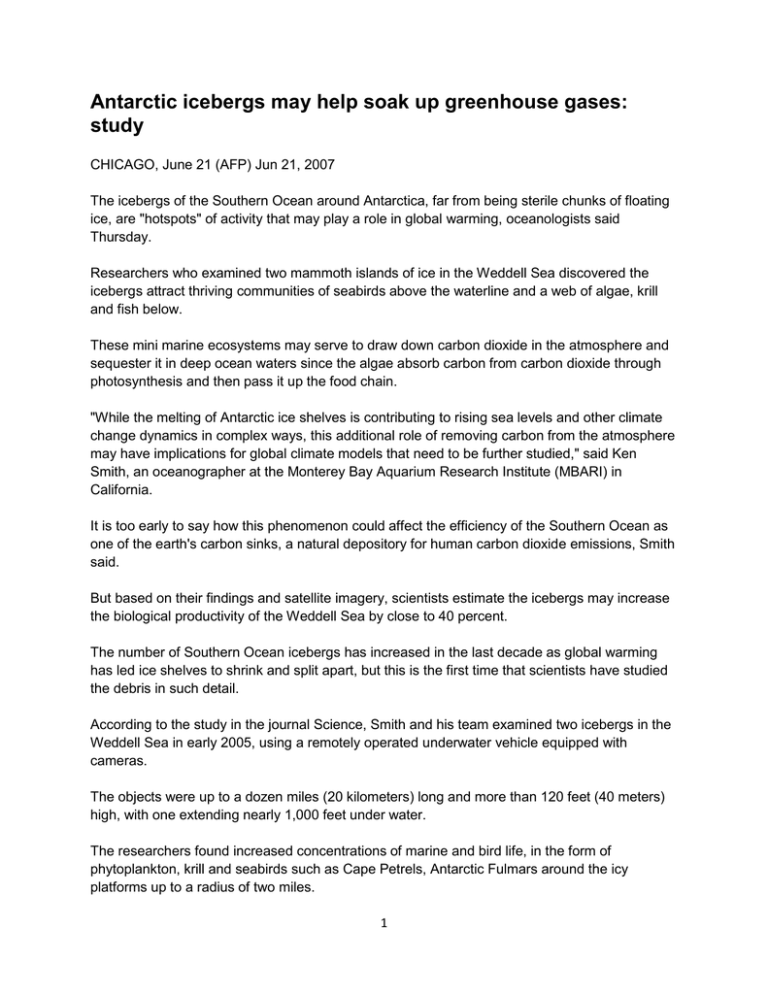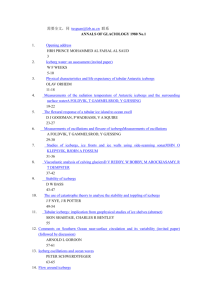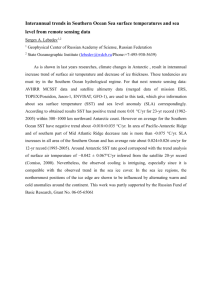
Antarctic icebergs may help soak up greenhouse gases:
study
CHICAGO, June 21 (AFP) Jun 21, 2007
The icebergs of the Southern Ocean around Antarctica, far from being sterile chunks of floating
ice, are "hotspots" of activity that may play a role in global warming, oceanologists said
Thursday.
Researchers who examined two mammoth islands of ice in the Weddell Sea discovered the
icebergs attract thriving communities of seabirds above the waterline and a web of algae, krill
and fish below.
These mini marine ecosystems may serve to draw down carbon dioxide in the atmosphere and
sequester it in deep ocean waters since the algae absorb carbon from carbon dioxide through
photosynthesis and then pass it up the food chain.
"While the melting of Antarctic ice shelves is contributing to rising sea levels and other climate
change dynamics in complex ways, this additional role of removing carbon from the atmosphere
may have implications for global climate models that need to be further studied," said Ken
Smith, an oceanographer at the Monterey Bay Aquarium Research Institute (MBARI) in
California.
It is too early to say how this phenomenon could affect the efficiency of the Southern Ocean as
one of the earth's carbon sinks, a natural depository for human carbon dioxide emissions, Smith
said.
But based on their findings and satellite imagery, scientists estimate the icebergs may increase
the biological productivity of the Weddell Sea by close to 40 percent.
The number of Southern Ocean icebergs has increased in the last decade as global warming
has led ice shelves to shrink and split apart, but this is the first time that scientists have studied
the debris in such detail.
According to the study in the journal Science, Smith and his team examined two icebergs in the
Weddell Sea in early 2005, using a remotely operated underwater vehicle equipped with
cameras.
The objects were up to a dozen miles (20 kilometers) long and more than 120 feet (40 meters)
high, with one extending nearly 1,000 feet under water.
The researchers found increased concentrations of marine and bird life, in the form of
phytoplankton, krill and seabirds such as Cape Petrels, Antarctic Fulmars around the icy
platforms up to a radius of two miles.
1
They attribute this "halo effect" to the fact that as the icebergs melt, they shed accumulated
terrestrial material "fertilizing" the surrounding waters.
The run-off appears to be rich in iron, which stimulates the growth of phytoplankton, the critical
building block for the whole food chain.
"The Southern Ocean lacks a major source for terrestrial material due to the absence of major
rivers. The icebergs constitute a moving estuary, distributing terrestrial derived nutrients that are
typically supplied by rivers in other areas of the oceans," said Timothy Shaw, a geo-chemist at
the University of South Carolina.
All rights reserved. © 2005 Agence France-Presse.
***
http://www.latimes. com/news/ printedition/ asection/ la-sci-icebergs2 2jun22,1,931670. story
Proliferating icebergs creating ecosystems
The drifting ice plays host to new communities of plankton, krill and seabirds that may
help absorb carbon dioxide.
By Amber Dance, Times Staff Writer
June 22, 2007
The proliferation of Antarctic icebergs caused by rising temperatures is creating a vast
ecosystem of plankton, krill and seabirds that may have the power to absorb some of the carbon
dioxide that is driving global warming, scientists reported Thursday.
The researchers, led by oceanographer Kenneth Smith Jr. of the Monterey Bay Aquarium
Research Institute, found that these new communities may cover a significant portion of
Antarctic seas.
The ecosystems use photosynthesis to take carbon from the atmosphere and convert it into
plant life and other forms of organic carbon that can be held in the ocean.
"I think it can be a substantial contribution" to reducing carbon dioxide levels, Smith said. "These
things have been ignored forever."
As glaciers move across Antarctica, they accumulate nutrient-rich dirt and dust. When the
glaciers break up, the resulting icebergs carry that material out to sea.
The researchers, who published their findings in the online version of the journal Science,
analyzed two icebergs in the Weddell Sea, at the southernmost part of the Atlantic Ocean.
They found that soil and other organic matter from the icebergs provided nutrients and support
for plankton and algae. Krill then fed on the plankton.
2
Scientists saw more seabirds, such as Cape petrels and Antarctic fulmars, near the icebergs
than in the ocean. This iceberg-influenced zone extended over two miles into the ocean from
the drifting ice.
Using satellite imagery, researchers counted 962 ice islands in an area of about 4,000 square
miles near their study area. Based on their data, they estimate that 39% of the region could
contain iceberg-influenced communities.
But the significance of icebergs in global carbon dynamics remains uncertain.
"While icebergs may be important on a local scale, I seriously doubt that their impact needs to
be accounted for in global carbon budgets," said Kevin R. Arrigo, a geophysicist at Stanford
University who wasn't involved in the study.
-amber.dance@ latimes.com
*** NOTICE: In accordance with Title 17 U.S.C. Section 107, this material is distributed,
without profit, for research and educational purposes only. ***
__._,_.___
3






